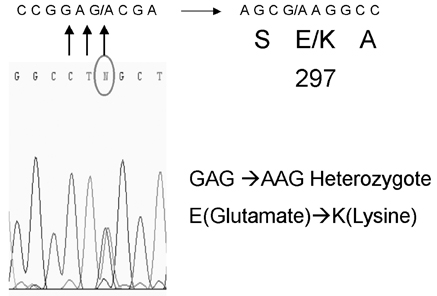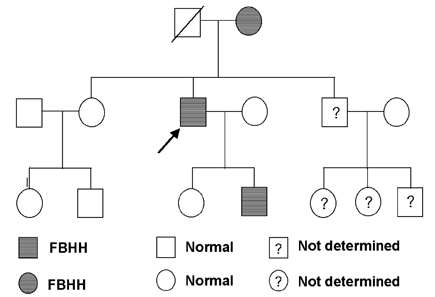Yonsei Med J.
2006 Apr;47(2):255-258. 10.3349/ymj.2006.47.2.255.
A Case Report of Familial Benign Hypocalciuric Hypercalcemia: A Mutation in the Calcium-Sensing Receptor Gene
- Affiliations
-
- 1Department of Endocrinology and Metabolism, Ajou University School of Medicine, Suwon, Korea. yschung@ajou.ac.kr
- 2Department of Urology, Ajou University School of Medicine, Suwon, Korea.
- KMID: 1110751
- DOI: http://doi.org/10.3349/ymj.2006.47.2.255
Abstract
- Familial benign hypocalciuric hypercalcemia (FBHH) is an autosomal dominant trait with high penetrance, clinically manifestating a relatively benign, lifelong, persistent hypercalcemia and hypocalciuria without hypercalcemic related complications. The calcium-sensing receptor (CaSR) plays an important role in the regulation of PTH secretion and calcium metabolism. Here we present a family with FBHH of an autosomal dominant inheritance. A heterozygous mutation of E297K (GAG -> AAG, exon 4) of CaSR gene was found in 3 family members. To our knowledge, it is the first confirmed case of FBHH with CaSR gene mutation in Korea.
Keyword
MeSH Terms
-
Sequence Analysis, DNA
Receptors, Calcium-Sensing/*genetics
Pedigree
Parathyroid Hormone/analogs & derivatives/genetics/metabolism
*Mutation
Metabolism, Inborn Errors/*genetics
Male
Korea
Hypercalcemia/*genetics
Humans
Heterozygote
Genes, Dominant
Female
Family Health
Exons
DNA Restriction Enzymes/metabolism
DNA/metabolism
Adult
Figure
Cited by 1 articles
-
Autosomal Dominant Hypocalcemia Caused by an Activating Mutation of the Calcium-Sensing Receptor Gene: The First Case Report in Korea
Mi Yeon Kim, Alice Hyun Kyung Tan, Chang-Seok Ki, Ji In Lee, Hye Won Jang, Hyun Won Shin, Sun Wook Kim, Yong-Ki Min, Myung-Shik Lee, Moon-Kyu Lee, Kwang-Won Kim, Jae Hoon Chung
J Korean Med Sci. 2010;25(2):317-320. doi: 10.3346/jkms.2010.25.2.317.
Reference
-
1. Fuleihan Gel-H. Familial benign hypocalciuric hypercalcemia. J Bone Miner Res. 2002. 17:Suppl 2. N51–N56.2. Pollak MR, Brown EM, Chou YH, Hebert SC, Marx SJ, Steinmann B, et al. Mutations in the human Ca2+-sensing receptor gene cause familial hypocalciuric hypercalcemia and neonatal severe hyperparathyroidism. Cell. 1993. 75:1297–1303.3. Chou YH, Brown EM, Levi T, Crowe G, Atkinson AB, Arnqvist HJ, et al. The gene responsible for familial hypocalciuric hypercalcemia maps to chromosome 3q in four unrelated families. Nat Genet. 1992. 1:295–300.4. Marx SJ, Attie MF, Levine MA, Spiegel AM, Downs RW Jr, Lasker RD. The hypocalciuric or benign variant of familial hypercalcemia: clinical and biochemical features in fifteen kindreds. Medicine (Baltimore). 1981. 60:397–412.5. Law WM Jr, Heath H 3rd. Familial benign hypercalcemia (hypocalciuric hypercalcemia). Clinical and pathogenetic studies in 21 families. Ann Intern Med. 1985. 102:511–519.6. Rajala MM, Heath H 3rd. Distribution of serum calcium values in patients with familial benign hypercalcemia (hypocalciuric hypercalcemia): evidence for a discrete defect. J Clin Endocrinol Metab. 1987. 65:1039–1041.7. Marx SJ, Spiegel AM, Brown EM, Koelhler JO, Gardner DG, Brennan MF, et al. Divalent cation metabolism. Familial hypocalciuric hypercalcemia versus typical primary hyperparathyroidism. Am J Med. 1978. 65:235–242.8. Firek AF, Kao PC, Heath H 3rd. Plasma intact parathyroid hormone (PTH) and PTH-related peptide in familial benign hypercalcemia: greater responsiveness to endogenous PTH than in primary hyperparathyroidism. J Clin Endocrinol Metab. 1991. 72:541–546.9. Rajala MM, Klee GG, Heath H 3rd. Calcium regulation of parathyroid and C cell function in familial benign hypercalcemia. J Bone Miner Res. 1991. 6:117–124.10. Stuckey BG, Kent GN, Gutteridge DH, Pullan PT, Price RI, Bhagat C. Fasting calcium excretion and parathyroid hormone together distinguish familial hypocalciuric hypercalcemia from primary hyperparathyroidism. Clin Endocrinol (Oxf). 1987. 27:525–533.11. Marx SJ, Attie MF, Stock JL, Speigel AM, Levine MA. Maximal urine-concentrating ability: familial hypocalciuric hypercalcemia versus typical primary hyperparathyroidism. J Clin Endocrinol Metab. 1981. 52:736–740.12. Friedrich CA. Von Hippel-Lindau syndrome. A pleomorphic condition. Cancer. 1999. 86(11):Suppl. 2478–2482.13. Pavlovich CP, Schmidt LS, Phillips JL. The genetic basis of renal cell carcinoma. Urol Clin North Am. 2003. 30:437–454.14. Houache OM. Extracellular calcium-sensing receptor: structural and functional features and association with diseases. Braz J Med Biol Res. 2001. 34:577–584.15. Pidasheva S, D'Souza-Li L, Canaff L, Cole DE, Hendy GN. CASRdb: calcium-sensing receptor locus-specific database for mutations causing familial (benign) hypocalciuric hypercalcemia, neonatal severe hyperparathyroidism, and autosomal dominant hypocalcemia. Hum Mutat. 2004. 24:107–111.16. Thakker RV. Diseases associated with the extracellular calcium-sensing receptor. Cell Calcium. 2004. 35:275–282.17. Pearce SH. Clinical disorders of extracellular calcium-sensing and the molecular biology of the calcium-sensing receptor. Ann Med. 2002. 34:201–206.18. Hu J, Spiegel AM. Naturally occurring mutations of the extracellular Ca2+-sensing receptor: implications for its structure and function. Trends Endocrinol Metab. 2003. 14:282–288.19. Hinnie J, Bell E, McKillop E, Gallacher S. The prevalence of familial hypocalciuric hypercalcemia. Calcif Tissue Int. 2001. 68:216–218.20. Bai M, Trivedi S, Kifor O, Quinn SJ, Brown EM. Intermolecular interactions between dimeric calcium-sensing receptor monomers are important for its normal function. Proc Natl Acad Sci USA. 1999. 96:2834–2839.
- Full Text Links
- Actions
-
Cited
- CITED
-
- Close
- Share
- Similar articles
-
- A Case of Familial Hypocalciuric Hypercalcemia Coexisting with Hypothyroidism
- A Case of Familial Hypocalciuric Hypercalcemia Coexisting with Low Bone Mass
- De novo a novel variant of CaSR gene in a neonate with congenital hypoparathyroidism
- Autosomal Dominant Hypocalcemia Caused by an Activating Mutation of the Calcium-Sensing Receptor Gene: The First Case Report in Korea
- Primary hyperparathyroidism versus familial hypocalciuric hypercalcemia: a challenging diagnostic evaluation in an adolescent female




